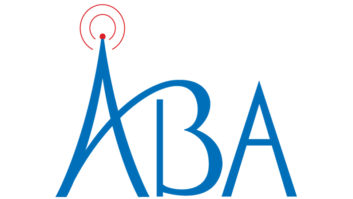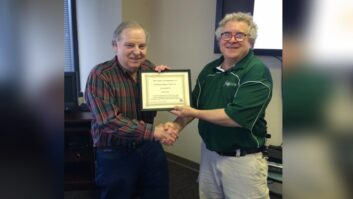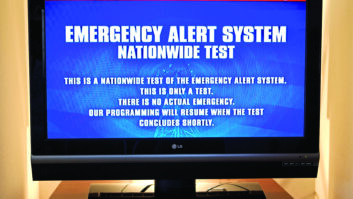Larry Wilkins is the recipient of the 2017–18 Radio World Excellence in Engineering Award.
Recipients represent the highest ideals of the U.S. radio broadcast engineering profession and reflect those ideals through contributions to the industry. He is the 14th person so honored.
“Wilkins has plenty of credentials as a traditional engineer, having retired as assistant director of engineering at Cumulus Media in 2007 as the capstone of a four-decade-long career in broadcasting,” Radio World Editor in Chief Paul McLane said.
“But it is his ongoing devotion to making our business better and helping people that really stand out. Well after retirement, he’s among the most active of local/statewide engineers in helping and educating others in modern tech concepts.
“We choose him in appreciation of his lifelong work as an engineer; his commitment to ongoing technical education, exemplified with local training programs as well as his weekly technical e-newsletter, which is read well beyond Alabama’s boundaries; his ability to explain complicated concepts in common language; his service to SBE both locally and nationally and to the Alabama Broadcasters Association; his work in EAS, including upgrades to the state’s system; his work in Amber alerts and the Alternative Broadcast Inspection Program; and for being a true friend to our industry.”
GETTING IN THE GAME
Wilkins, 74, is a lifelong Alabamian — a native of Enterprise and current resident of Prattville, where he lives with his wife Cathy.
Like many of his cohort, Wilkins got bit by the radio bug early and worked at a local 1 kW daytime AM station as a high school student. He remembers that his responsibilities at WIRB ranged from “from reading the obituaries, to playing records and taking out the trash.” He began as a board op, but the station’s engineer, a retired Army colonel named Harvard Rawlinson, noticed and encouraged his interest in broadcasting’s technical side.
He graduated from Enterprise High School in 1961 and went on to pursue his education at a local trade school on the recommendation of his WIRB mentor, who also advised him to learn basic electronics because “electricity flows the same way” in washing machines and radio transmitters. Wilkins also studied the basics of radio and television technical operation.
Upon graduation in 1963, Wilkins took a job at the NBC affiliate WSFA(TV) in Montgomery, working under engineer Dick Payne.
After about two years, Wilkins had the opportunity to build a television station. He initially hesitated, but Payne encouraged him to tackle the learning experience. Wilkins saw WCFT(TV) from a concrete slab to functioning station. Despite all the mistakes Wilkins says he made, the station went live when he pushed the buttons. The experience reinforced Wilkins’ belief that mistakes are a crucial part of growth and learning, even in a professional setting.
The second time Wilkins worked at WSFA, the facility transitioned from black-and-white to color; he describes the experience as a “real learning curve for all.”
A few years down the road, General Telephone hired Wilkins as a training instructor, teaching video and microwave transmission.
Over the years, Wilkins has worked at other radio and television facilities in Alabama in various roles. He was chief engineer for WIRB(AM/FM) in Enterprise; staff engineer for WSFA(TV) in Montgomery; chief engineer for WCFT(TV) in Tuscaloosa; staff engineer for WTVY(TV/FM) in Dothan; chief engineer for WKAB(TV) in Montgomery; and chief engineer for WKMX(FM) in Enterprise. He spent several years as the microwave technician for the Alabama Public Television Network, the first U.S. public television network.
Wilkins served on the original board of directors and was first chief engineer for Faith Radio (WLBF Montgomery, which has transmitters in Dothan and Andalusia).
Also in Montgomery, Wilkins designed and oversaw the construction of the multi-station master antenna project for WLWI, WHHY, WXFX and WBAM.
A GOOD SPORT
A career highlight came at Montgomery’s WLWI(FM), which Wilkins designed and constructed in 1979. The station eventually expanded into a network of seven stations, and the company had the rights to Auburn University sports broadcasts. This meant Wilkins was in charge of handling the onsite engineering for Auburn football and basketball games.
Wilkins and his engineering team designed and installed the Alabama Digital Satellite Network, which distributes not only Auburn Sports but also the cross-state rival University of Alabama Sports Network.
He parleyed this sports experience into a few other gigs: Wilkins worked as on-site engineer for the short-lived U.S. Football League’s Birmingham Stallions for three years — a move Wilkins says he made because “he didn’t have more sense at the time,” since he was working full-time for Cumulus. When Wilkins quit that job, he told them that he’d seen too many football games. (That didn’t stop him from doing frequency coordination work for Auburn.)
He also worked as a freelance engineer with ABC TV, covering SEC football, and CBS Radio for SEC basketball.
Asked if he considers himself a sports fan, Wilkins replied, “Very much so.” Although not an athlete (he played trumpet in the band), he was involved with the PA system for games, and WIRB covered high school football games on the air while he worked there.
He says his loyalty lies with Auburn, but admits he is somewhat of a mercenary. “Well, I guess if Troy State University signed my checks, I’d be a Troy State fan.”
Cumulus Media purchased the Montgomery station group in 1997, and Wilkins was promoted to assistant director of engineering. In this role, he worked under Terry Baun (former SBE president), until Wilkins’ retirement in ’07.
Baun and Wilkins have stayed in touch over the years, and Baun applauds Wilkins’ work with the ABA.
“Larry exemplifies excellence in engineering, not only for the work he does directly, but perhaps more importantly for what he does in training future generations of engineers at his seminars for the Alabama Broadcasters Association,” Baun said.
“He is a skilled taskmaster, but always ready with a quick joke or a funny story to emphasize the topic he is teaching, and at the end of the day he has prepared his students for their first steps in our industry and contributed once again to the future of our broadcast engineering community.”
PROFESSIONAL DEVELOPMENT AND SERVICE
Wilkins became involved with the Society of Broadcast Engineers in 1991 and served two terms on the national board of directors; today he serves on the society’s certification committee. He holds Certified Professional Broadcast Engineer (CPBE), AM Directional (AMD) and Certified Broadcast Network Technology (CBNT) certifications.
In 2005, the SBE honored Wilkins with its “Engineer of the Year” award and elevated him to the rank of fellow in 2013.
He is chair of the Alabama EAS Committee and serves on the Amber Alert task force for the state.
Wilkins helped to develop Alabama’s state plan for the transition from EBS to EAS in the mid-1990s.
“One of my goals was to develop a real redundant system, to improve the distribution system,” Wilkins said.
Wilkins has also served on the Alabama Broadcasters Association’s EAS committee for many years and has long considered alerting to be an important aspect of broadcasting. In fact, one of his first roles with the ABA was to ensure that stations were in compliance with FCC regulations and rules.
A SECOND CAREER (OR TWO)
In 2006, Alabama’s Alternative Broadcast Inspector Angle Ditty retired; he encouraged Wilkins to take the reins.Then in his mid-80s, Ditty decided to restrict his inspections to his home state of Georgia. (He has since passed away.)
“I’ve always really enjoyed going around to different radio and TV stations and meeting new people. You learn so much,” Wilkins said.
He also conducted inspections in South Carolina until recently — a job he left because he wanted to save the South Carolinians money on his travel costs, and because he needed to make room in his schedule for the Alabama Engineering Academy.
With his 2007 retirement, Wilkins partnered with the ABA to create the association’s Engineering Academy. He says its aim is to create a pool of new engineers for the broadcast industry.
The idea for the training center began at an ABA meeting, where local GMs expressed concern about a lack of young talent coming into the market. College broadcasting schools wouldn’t be the solution, since their focus had largely shifted away from technical skills. Several board members asked, “Can we start our own engineering school?”
Wilkins agreed the idea was worth review. As an engineer and a member of the SBE education committee, it’s not surprising that Wilkins determined that the curriculum should be loosely based on SBE certifications.
“When we started the Engineering Academy, I discovered how much there is to learn about the technical side of broadcasting, and that it is changing at such a rapid pace; we must keep up or risk falling behind quickly.”
The increased focus on IT plays into the curriculum. Nonetheless, he still believes in the fundamentals.
“Because of the move to digital audio and transmission, it is important that engineers develop a basic knowledge of computers and how digital functions. Engineers need to ‘look under the hood’ of digital audio to understand how it works. If you don’t, fundamentals mistakes can be made, which can make your operations a B instead of a A+.”
He continued, “A lot of technology has been ‘phased out.’ However, understanding even those technologies, I think, makes you a better or more informed engineer. … If you don’t understand the basics, the rest of it will go right over your head.”
The Engineering Academy is also an opportunity for Wilkins to evangelize passions, such as mixing audio.
Earlier in his career, like many engineers, Wilkins moonlighted setting up and mixing live audio for concerts, church services and other events. He credits this work with providing him a good understanding of how audio is perceived by the human ear. This skill has been invaluable in teaching the proper installation and configuration of audio equipment in a broadcast operation, Wilkins says.
In 2016, he added a course that teaches engineers how to create a good mix, which is certainly a building block of a quality broadcast. The “Mixing Live Audio Seminar” also is targeted to churches. Wilkins explains the connection: Some stations air church services, and so if the original mix is flawed, there’s less that can be done on the radio end.
Ultimately, Wilkins says, it’s not the equipment so much as learning how to use it.
“It appears to me that due to the rapidly changing technology, engineers are eager to keep up, so as a result we have a level of technical ability that continues to increase,” Wilkins said. “Engineers that don’t keep up won’t be around very long.”
The academy is in its fifth year, and its scope has expanded far beyond the original goal of educating engineers in Alabama’s local markets.
The classes have attracted students from outside of Alabama — from all around the country, in fact. According to Wilkins, the prize for the longest journey goes to a woman who flew in from Alaska to learn about radio.
Not surprisingly, Wilkins relishes the work. “Teaching was something I had never done, but I told my wife Cathy that if I had known how much I enjoyed it, I probably would have started it earlier.”
Alabama Broadcasters Association President Sharon Tinsley is effusive in her praise of Wilkins.
“Larry Wilkins is amazing. We are so fortunate in Alabama to have him as a resource of engineering knowledge and skill,” Tinsley wrote in an email to Radio World (emphasis hers). “Larry is the backbone of our Engineering Academy and our EAS system. In addition, he’s always willing to do outreach in public schools to help introduce students to the concept of broadcast engineering as a career path.
“A few years ago, we bestowed the honor of [Alabama] Broadcaster of the Year on him — a unanimous choice.”
Wilkins explains his work with the ABA has allowed him to continue his association with broadcasting — without the time constraints or stress of full-time engineering.
HONOR ROLL
Recipients of the Radio World Excellence in Engineering Award represent the highest ideals of the U.S. radio broadcast engineering profession and reflect those ideals through contributions to the industry.
2017 Larry Wilkins
2016 Michael Cooney
2015 David H. Layer
2014 Wayne Pecena
2013 Marty Garrison
2012 Paul Brenner
2011 Barry Thomas
2010 Milford Smith
2009 Gary Kline
2008 Jeff Littlejohn
2007 Clay Freinwald
2006 John Lyons
2005 Mike Starling
2004 Andy Andreson
In fact, semi-retirement has afforded him time to cultivate a new hobby with his wife: rose gardening. Both are members of the Montgomery Rose Society and the American Rose Society, and Wilkins was president of the former. At the height of his enthusiasm, they had about 125 plants in their yard but have now winnowed that to a more manageable number.
But even his gardening passion can be traced back to engineering. One day, Wilkins was visiting a transmitter site and came across a nearby garden, full of beautiful rose bushes. He stopped to admire them and learned that a retired school teacher tended them. Once again, Wilkins was hooked.
“I’ve always loved to grow things,” Wilkins explained.
Even in his pseudo-retirement, Wilkins remains a dynamic member of the broadcast community. One thing he doesn’t miss from the earlier days of radio? Stress. Being a “corporate engineer” came with plenty of headaches and long nights.
“Cathy has been extremely supportive of my carrier over our 31 years of marriage, and I thank her for all the encouragement she has given. It is not easy being married to a broadcast engineer, as transmitters quite often pick the worst times to fail.”
Nonetheless, Wilkins says “the broadcast and multimedia business is something that gets in your system and never leaves.”







